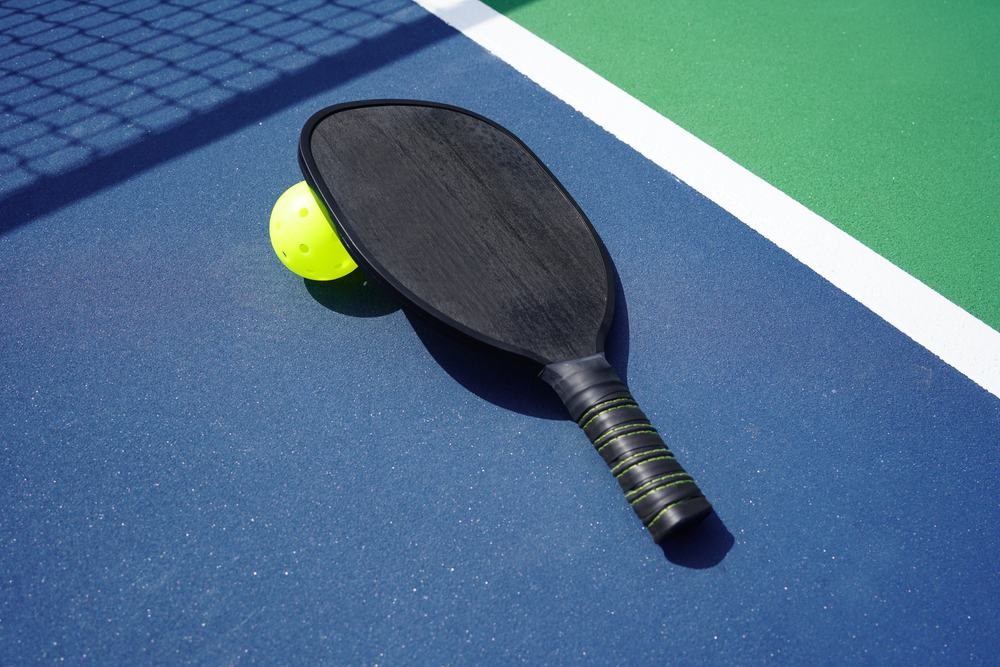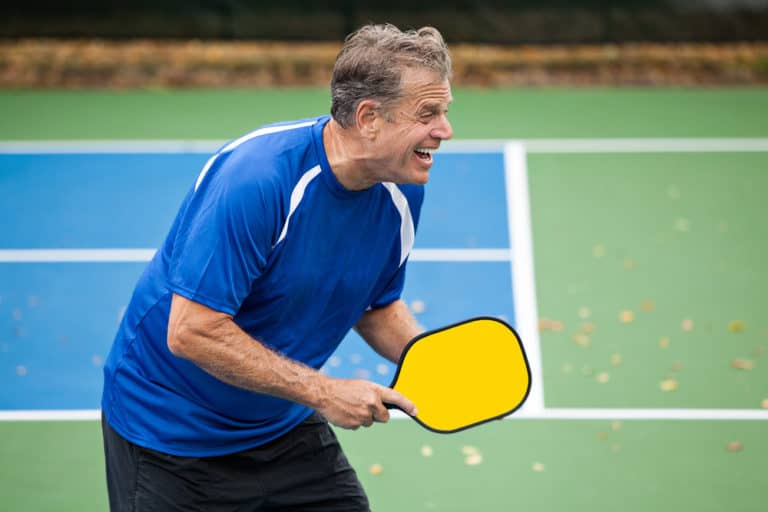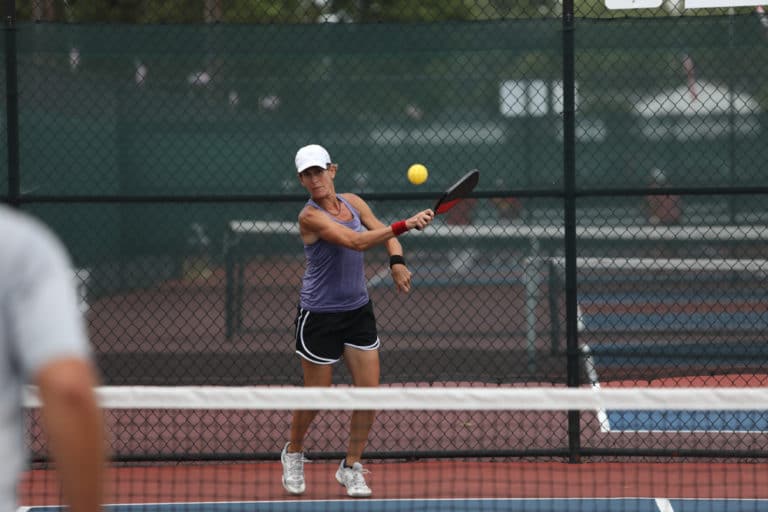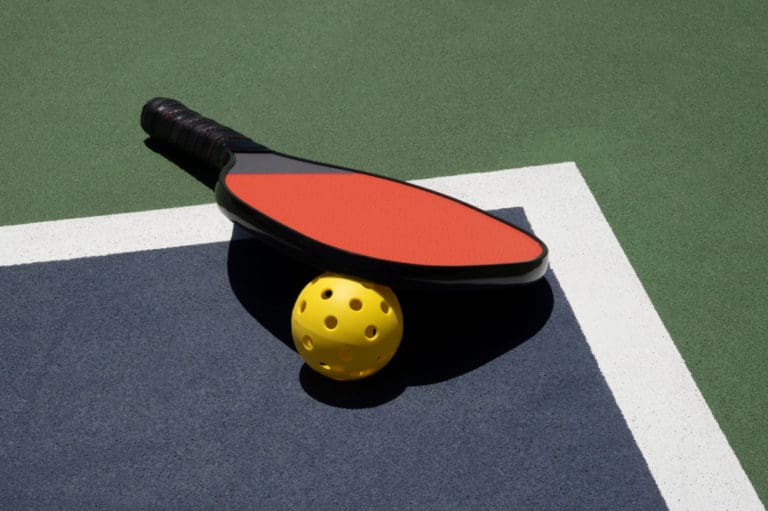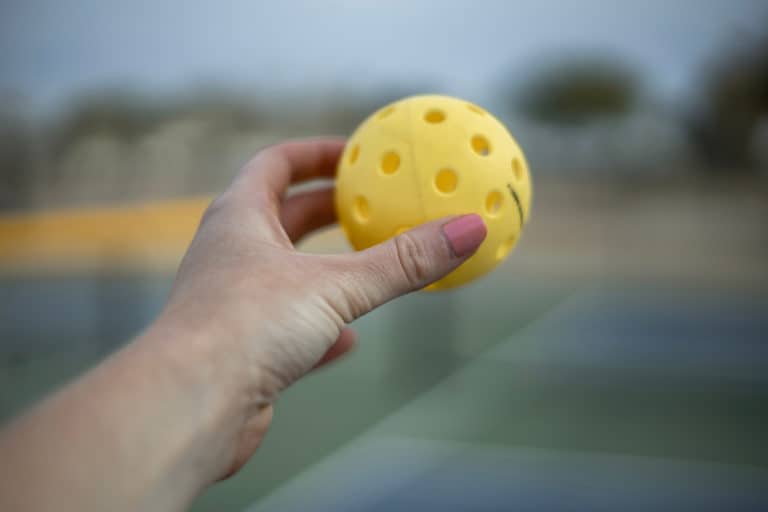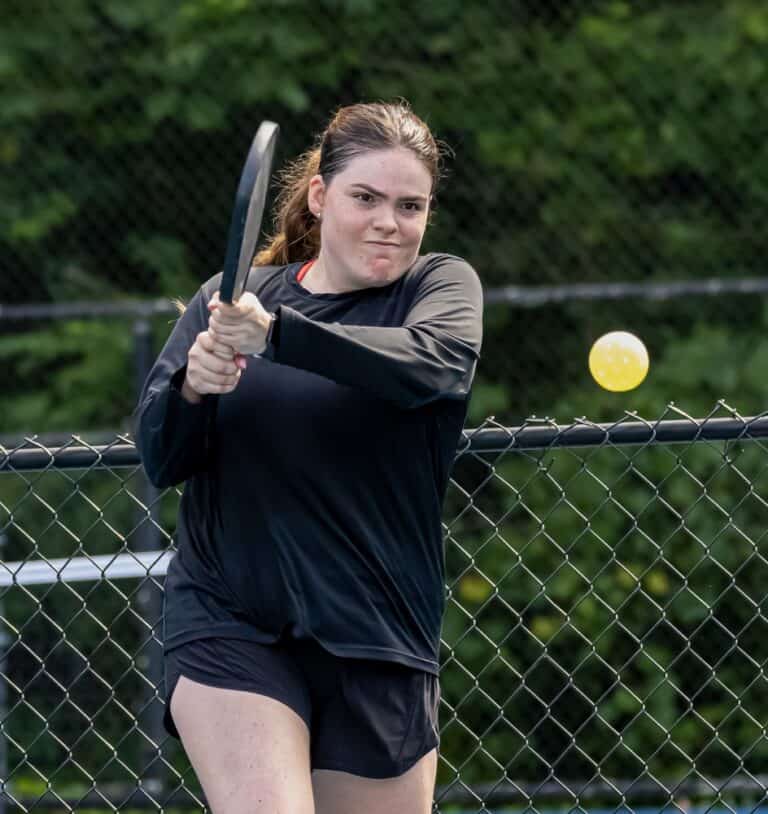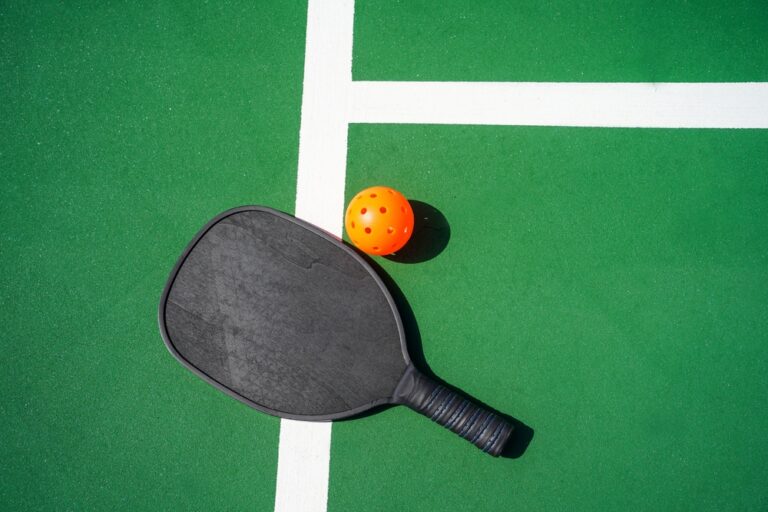What Is The Standard Size Of A Pickleball Paddle?
If you’ve spent any time on a pickleball court, you’ve probably noticed that not every paddle has the same shape and size. While traditional paddles have a wide body, I’ve always preferred the elongated shapes for the extra power! However, what is the standard size of a pickleball paddle?
The standard pickleball paddle is 16 inches in length and eight inches wide. The handle is four inches long with four inches in circumference. According to USAPA specifications, a pickleball paddle’s combined length and width, including the edge guard and butt cap, may not exceed 24 inches.
The body shape, size, and weight contribute a tremendous amount to your performance on the court. It can give you more power during your shots, improve your reach, and even improve your game at the kitchen line. Let’s explore these features to learn more!
What Is The Standard Size Of A Pickleball Paddle?
The standard pickleball paddle measures 15.5 – 17 inches (39.37 – 43.18 cm) in length and 7 – 8.25 inches (17.78 – 20.96cm) in width. The handle is 4 – 6 inches (10.16 – 15.24cm) long with 4 – 4.5 inches (10.16 – 11.4cm) in circumference. Lastly, the combined length and width, including any edge guard and butt cap, may not exceed 24 inches (60.96 cm).
Pickleballs come in different shapes and sizes that cater to players’ height, preferences, and capabilities on the court. Some paddles have a broader body shape while others are slim and narrow; their different handle lengths and body shapes can enhance or hinder your performance.
Pickleball Paddle Shapes Make A Noticeable Difference
Elongated paddles are typically 1 – 2 inches longer than traditional paddles, making it easier to reach higher shots. However, you will need to be a little more accurate with your shots as there is less surface area and thus a smaller sweet spot.
Broad Shape Pickleball Paddles
Generally, paddles with a broader body shape make it slightly harder to generate power because the head is not as heavy and concentrated as an elongated paddle. For example, hitting a ball with a wooden baseball bat will make it travel further than if you were to hit it with a larger, flat piece of wood – the power focuses on one specific area, namely the bat’s tip.
Furthermore, since the paddle is 1 – 2 inches shorter, you’ll have slightly less reach, making it more challenging if you’re shorter than most other players. The difficulty can be especially prevalent when playing at the kitchen line and reaching for the ball.
Shorter reach also means you will need better footwork to chase down and position yourself in the right place to avoid missing a shot. The shorter and wide paddles usually feel softer and allow for quick exchanges at the kitchen line because it’s easier to swing around than a longer paddle.
Of course, a wider body also means that the sweet spot will be easier to hit, enhancing your gameplay with more accurate shots.
Elongated Pickleball Paddles
Elongated pickleball paddles are generally the more comfortable choice for players from a racquet sports background such as tennis or racquetball. Since the body shape is narrower, there’s less surface area, so you need to be more precise with your shots to land them in the middle if you want to get the most out of your shots.
In fact, if you are off-center even slightly, you’ll miss the sweet spot, and the ball might bounce off the rim and create a mess for your game. When you find yourself at the kitchen line trading quick shots, your reaction may be slower because you need more time to adjust your position and paddle for that perfect shot.
The longer body enables you to make more powerful shots at the net, thus improving your offensive potential. For example, moving a long stick around your body will be considerably more time-consuming than moving a shorter stick. Additionally, elongated paddles are excellent for driving balls from the back and deeper into the opposition’s side of the court.
One of the most instrumental advantages of an elongated paddle is the extra 1 – 2 inches of reach. When you’re standing at the kitchen line with arms outstretched on either side of your body, the seemingly minor gain will be the difference between you smashing the ball onto your opponent’s side and being forced into a defensive, blocking position from the opposition.
Typically, professional players do not have difficulty hitting the ball in the sweet spot. Furthermore, they also don’t have an issue directing the ball to where they want it. For this reason, most advanced players will prefer having more reach over a more prominent sweet spot.
So, Elongated Or Wide Body?
There is no right or wrong conclusion, although it is true that these paddles favor two different play styles.
Consider a wide-body paddle if you are a more methodical player who prefers to control your playspace with quick and careful movement. Players who favor an aggressive and somewhat opportunistic playstyle by leaning on the offensive will find that an elongated paddle fits like a glove.
How Do You Pick The Best Pickleball Paddle Size?
While the right pickleball paddle should fit comfortably in your hand and compliment your defensive or offensive playstyle, the weight of your paddle is the most vital attribute that determines paddle size.
Despite which body shape you choose, you won’t be able to successfully compete with a paddle that is too heavy or too lightweight.
Is It Better To Have A Lightweight Or Heavy Pickleball Paddle?
When you consider the weight of your paddle, you must remember that a paddle can be heaviest at the top (head-heavy) and heaviest at the bottom (handle-heavy). Together, these weights make up the swing weight of a paddle.
A Pickleball Paddle Has Swing Weight
The concept of swing weight is crucial because it can affect your arm depending on the torque behind the paddle when you swing it.
The swing weight of the paddle will consist of its gross weight plus how heavy the paddle is at its head region. Combining these two elements will give you an estimate of the kind of swing weight you should consider.
It’s important to distinguish that swing weight is not the same as the total mass of the paddle. For example, two different paddles can weigh 7.5 ounces, but their swing weight can be entirely different because one is head-heavy (heavier at the top), while the other is handle-heavy (heavier at the bottom).
Typically, longer paddles have a higher swing weight than shorter ones because they are usually head-heavy. When you swing a heavier paddle through the air, it will exert more force and generate a more powerful hit than something significantly more lightweight. For example, a paddle made from paper won’t have nearly the same amount of power as a graphite paddle.
In such a case, more powerful shots will impart more torque and resistance between the ball and the paddle, so you will be much more likely to feel the impact run into your hands, wrists, forearms, and elbows. Thus, playing pickleball for extended periods will tire your hand more quickly and cause potential injuries.
How Would Head-Heavy And Handle-Heavy Paddles Play?
If you were to swing a mini-sledgehammer around the court for three hours, there is a high risk of hurting your wrist. At the same time, maneuvering such a heavy object is more complicated and requires immense strength and well-established muscle memory to maintain a steady playing performance.
On the contrary, going onto the court with a feather will have you swinging for hours with minimal effort and risk injury to your wrist, forearms, or elbows. Of course, lighter paddles will also mean less power behind every shot, but you gain more control and finesse.
Swingweight will affect each individual differently due to our body size or type. If you’re a player that has powerful arms and makes excellent power shots, you may want to consider a paddle that provides more control and precision to introduce a little order into your playstyle.
Similarly, some players may want more power behind their shots and opt for a head-heavy paddle.
How Do You Know Which Swing Weight Is Best For You?
You can decide on a suitable swing weight by doing a quick little experiment.
- Take the paddle you wish to try and grip it in your hand without clenching your closed hand.
- Ensure that your arm and elbow are not tense, and swing the paddle from left to right, letting it follow its own movement rather than having your hand or arm move it.
- Get a good feel for the motion: it may feel like you’re dragging it through water or pulling something from the paddle’s head area. That said, you may not feel this kind of resistance.
If you experience the water effect and feel some resistance, you’re dealing with a head-heavy paddle. If there’s little resistance when the paddle moves from left to right, it’s a handle-heavy paddle.
Typically, singles players opt for head-heavy paddles because they require more power to drive the ball forward and deeper onto the opposition’s side of the court. Since fewer people are on the court than in doubles, defensive capabilities are less prominent, and an offensive playstyle is more effective.
Players who play doubles will prefer a paddle that is not so head-heavy, making it easier to swing and maneuver around the court. Since there are more bodies on the court during a doubles game, there are more variables to respond to, so the extra mobility can be invaluable. Lightweight paddles allow for easier dinks, lobs, and better control during volleys at the kitchen.
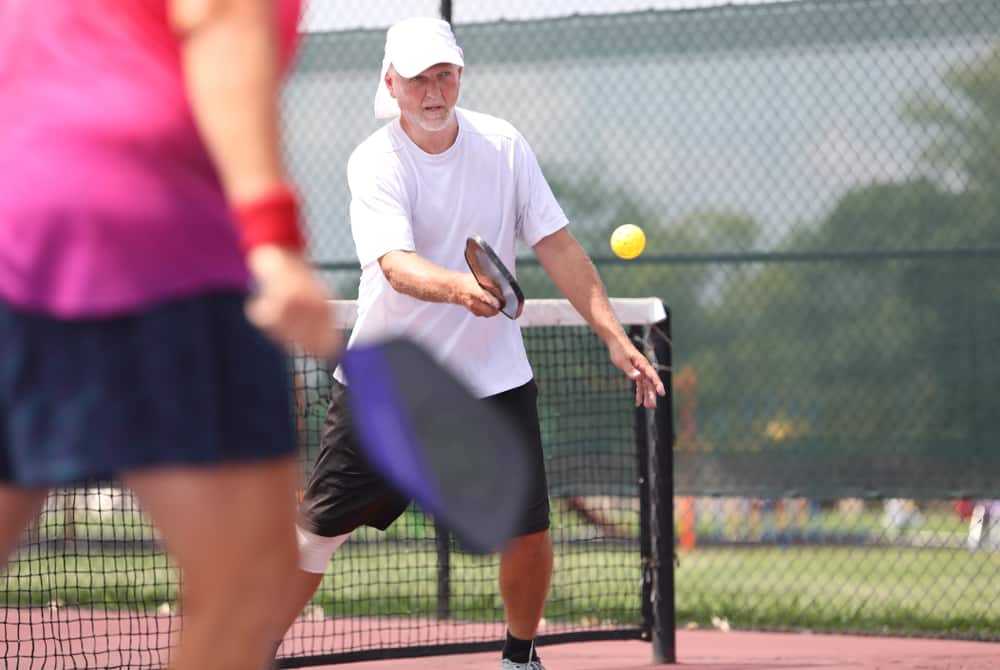
Should You Use Long Or Short Handles?
One of the most crucial design features of a paddle with a long handle is that the weight is much further away from your hand than usual. When you hold an elongated paddle, it’s normal for your hand to position itself near the bottom of the handle.
As a result, the sweet spot of an elongated paddle will be higher up than a shorter paddle, offering more whip and snap from your shots. The extra whip puts more power behind every shot, allowing them to travel faster and allowing you to be more offensive.
Of course, it also means you need to be more precise with your shots because the sweet spot is smaller. You’ll also notice that elongated paddles are harder, allowing for better dinks and an overall more rigid playstyle. Players may also prefer longer handles because they can fit both hands for an ultimate 2-handed backhand shot to take their opponent by surprise.
People who come from a tennis background and are comfortable with 2-handed shots will feel right at home with long handles. Of course, since the body is so narrow, the sweet spot is hard to hit.
That said, many players swear by shorter, wider paddles because they see little reason to sacrifice a larger sweet spot for more offensive potential – especially when standing at the net, which is arguably a large portion of any pickleball game.
Whether you cross the finish line fifty meters before the competition or five, it’s good to examine how you want a specific paddle to improve your game.
What Is The Significance Of Paddle Core Thickness?
Cores usually go up to 16mm in thickness. Thicker core paddles will absorb more impact when you make power shots or receive them. They have a softer feel, helping players focus on finesse rather than being overwhelmed by the explosion when the ball bounces off the paddle. You may lose some power with the really thick cores, but it’s not game-breaking.
The demand for a more stable paddle that yields more uniform shots throughout the surface led to a larger core. When the ball lands towards the paddle’s edge, it is less prone to twist in your hand, and it has a lower level of elasticity or resistance to being bent due to stress.
The difficulty in placing a ball where you want it on the court is that various sections of the paddle transfer energy to the ball in different ways. The sweet spot on a paddle refers to the point on the paddle where the ball receives the maximum energy. Shots that miss their aim are the most damaging and ineffectual.
Conclusion
The standard pickleball paddle is 15 inches long and 8 inches wide. Their body shape is wide to provide a more prominent sweet spot that makes it easier to use. Their handles are shorter than elongated paddles, making it harder to fit both hands for a 2-handed backhand.
Sources
- https://www.youtube.com/results?search_query=standard+pickleball+paddle+size
- https://www.youtube.com/watch?v=B22jkueb2dg&ab_channel=TylerKaChingLoong
- https://www.dimensions.com/element/pickleball-paddle
- https://usapickleball.org/docs/ifp/USA-Pickleball-Rulebook.pdf
- https://www.youtube.com/watch?v=i4l7QBhS3nM&ab_channel=PickleballKitchen

